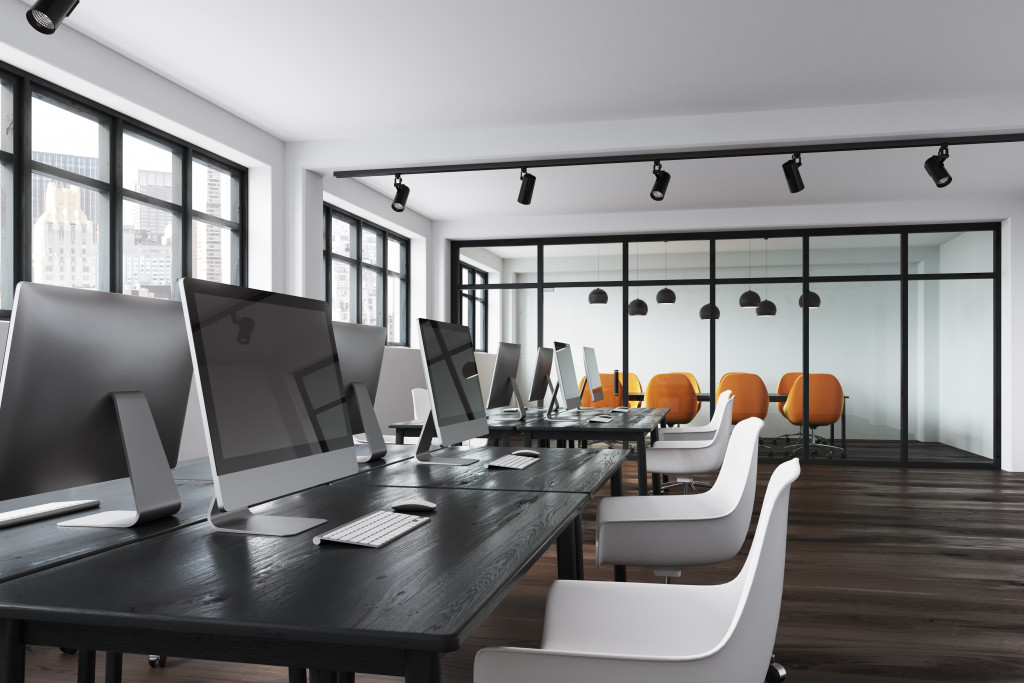Safety should always be the top priority in any workplace. It is essential to ensure that all employees, customers, and visitors feel safe and secure while on-site. Creating a safer workplace can help increase employee morale, reduce liability risk, and improve overall productivity. This guide will discuss four ways businesses can enhance their office space with safety features to create a safer work environment for everyone involved.
1. Install Proper Lighting
Poor lighting can pose serious risks for both workers and visitors alike. One of the essential steps to creating a safer business office is installing proper lighting throughout the facility. Make sure that hallways, stairwells, storage areas, parking lots, and other high-traffic areas are well-lit. Also, consider installing motion sensor lights to reduce energy costs and provide additional security.
When it comes to lighting, you want to ensure that each area is illuminated with sufficient lumens. Depending on the area and its purpose, you may need task lighting or more general ambient lighting. Consider using brighter lights in areas where tasks requiring detailed work take place. Consider adding highlights in certain areas for visibility for corridors and stairwells.
In addition to lumens, you’ll also want to consider the color temperature of your lighting. Warmer colors are often used in areas that require critical visual tasks, such as offices or machine shops. On the other hand, cooler tones can be used in general work areas.
2. Secure Entryways
It is vital to ensure that entry points into the building are adequately secured. Installing a secure locking system, such as an electronic access control system, can help restrict who is allowed in the facility while allowing legitimate visitors quick and easy access when needed. Additionally, you can install surveillance cameras around doors and windows to deter potential intruders or vandals.
In addition to the physical security measures taken at entryways, the right personnel policies and procedures should be in place. Not allowing unknown persons on the premises is essential without verifying their identity. It is also a good practice to check all visitors’ bags or packages before they enter, as this can help prevent any unauthorized items from being brought into the building. It is also vital that all employees, visitors, and contractors sign in and out of the facility to ensure no one lingers without permission.
It may be beneficial to install an intercom or two-way communication system so that visitors can easily communicate with someone inside the facility when they arrive, allowing access to authorized people. In addition, having a security guard at entry points and requiring all visitors have an appointment helps further restrict access.
3. Fire Prevention Equipment

Businesses should always have a fire prevention plan with the appropriate equipment in an emergency. Fire extinguishers should be placed strategically throughout the office, as well as a smoke detector and carbon monoxide monitor. Additionally, fire exits should be marked and unobstructed to ensure that everyone can evacuate quickly in an emergency.
It’s also essential to ensure that all staff knows the fire prevention plan and location of equipment. You should conduct regular drills to ensure everyone knows what to do in an emergency. Furthermore, staff must be trained to safely use fire prevention equipment and understand when it should be used. Fire extinguishers should also be inspected, maintained regularly, and tested to ensure they are in proper working order.
Businesses must take the necessary steps to reduce any potential fire risks. This includes ensuring all electrical wiring is up-to-date, avoiding flammable materials when possible, and avoiding overcrowding of furniture or equipment. All staff should be aware of fire safety protocols and know how to react in the event of a fire emergency adequately.
4. Ensure Parking Space is Secure
Another critical safety feature to consider is the parking lot. Ensure the pavement or asphalt is in good condition and free of any cracks, potholes, or other damage. In addition, light poles should be placed throughout the area for added visibility and security. Also, it’s a good idea to post warning signs near the entrance and exit of the facility regarding speed limits and other regulations.
Finally, consider sealing for your driveway to complete the security of your parking lot. Sealing will fill in any cracks and small holes that could otherwise cause damage to vehicles or provide opportunities for theft. It will also help protect against wear and tear due to water seepage over time. Furthermore, it can improve the aesthetic appeal of your lot by giving it a smooth and professional look.
Regarding parking lot security, access control is another critical component. You can use access control systems to limit entry and exit points and set different access restrictions based on the time of day. This can help deter unwanted visitors while still allowing legitimate customers in. Investing in an automated system that enables customers to pay for their parking remotely is also a good idea. This reduces lines and waits and gives customers peace of mind knowing they can securely access their vehicle without walking long distances or searching around for their tickets.
In Summary
Creating a safe and secure work environment should be a top priority for businesses of all sizes. With these four simple steps, businesses can proactively enhance their office space with safety features that will ensure employees, customers, and visitors feel comfortable on-site. Doing so can help reduce liability risks and improve overall productivity for your business.

